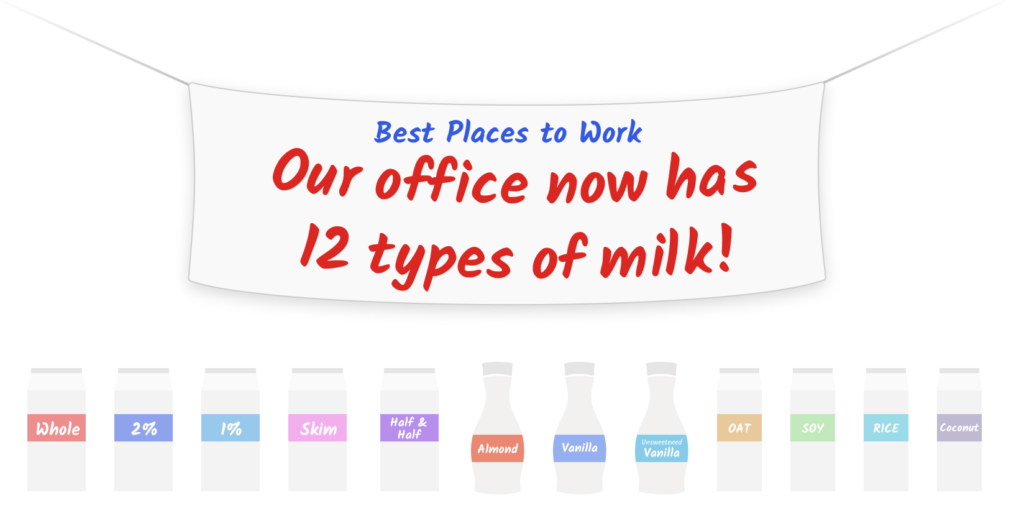
In the 2010s, companies finally recognized that the cultures they create matter.
Culture is now the most important factor for employees choosing between jobs. Meanwhile, competition has soared in the market for top talent, even as the economy cools. This is especially the case in tech, where experts warn that employees are still “in the driver’s seat.” And since the cost of turnover is between 90% and 200% of that employee’s salary, organizations can’t ignore the connection between creating great employee experiences and bolstering their bottom line.
In response, organizations are investing in HR. HR budgets are expanding as the department – often called People Operations now – becomes more proactive. The standard ratio for HR to other employees used to be 100-to-1. In high-growth, knowledge workplaces, it’s becoming 40–1, 30–1, or even 20–1.
Yet, despite significant awareness and investment to improve employee experiences, companies still have progress to make. Employee engagement rates remain low, with many people continuing to feel unrecognized, underappreciated, and unconnected at work. It’s not surprising then that turnover is still a looming concern for 91% of HR leaders.
The next phase of People Operations is on its way to address these issues. Here are a few of the obstacles that teams will have to overcome along the way.
Find the right technology to support your People Operations team
Get the ultimate HR tech buyer’s guide
Too many employers throw money at perks and fancy offices and say that they have created a great culture. These extras have very little impact on retention or employee satisfaction. An employee who feels unsupported as a parent isn’t going to stay at a company because they offer subsidized gym memberships or cold brew on tap.
Giving your employees beer kegs and ping-pong tables to solve complex cultural problems recognizes the need to invest in the relationship, but is a complete miss on where to put that investment.
It seems intuitive that a fun office ≠ a good culture. But employee experience budgets reveal how deeply ingrained the misconception is.

Employee experience budgets focused on perks like snacks aren’t associated with company-wide goals and don’t impact your employees’ actual day-to-day experience.
Often, perk budgets aren’t even associated with company-wide goals. Without metrics, there’s no accountability. So you’ll keep buying Kevin that $10/gallon oat milk, hoping that it has some impact on his lifetime at your company. Spoiler: It doesn’t.
Recognize that culture is not all about fun and perks. The human experience you create for your employees is more important than any exciting incentive you might offer – especially in a remote environment.
People Operations is every bit as complex as other forms of operations within an organization. As you do with other operations teams, give them company-wide goals and think about ways to constantly improve efficiency and scalability. Then monitor progress toward those goals, including tracking employee sentiment.
Your talent doesn’t randomly show up at work one day and decide that they don’t like where they are.
The moment an employee decides to look for a new job is a result of a negative trigger. While frustration can build over time, key events cause employees to start to look elsewhere. Researchers call these moments “shocks.”
Consider the following common inflection points when employees take a step back and think about where they are now and where they need to be, both professionally and personally:
What’s most interesting about these trigger points is that they are often predictable. We know when someone is passed up for a promotion or returns from leave. Information about who isn’t getting 1:1 support should be available internally via a people operations platform.
But managers and People Operations teams can only take action to provide proactive support if they have this information at their fingertips. Otherwise, it can be difficult to capture all of these critical junctures.
Even more obvious moments don’t receive the attention they should. Birthdays and work anniversaries are downplayed, even though they are low-hanging-fruit opportunities to recognize employees. And every time those milestones roll around, employees are more likely to take stock of their current situation and look elsewhere. Job search activity jumps 9% for employees around the time of their work anniversary and 12% around their birthdays. Those numbers are even higher for major landmarks, like five year anniversaries or 40th birthdays.
Research reveals that job search activity jumps when individuals reach key milestones, making it important for People Operations teams to proactively celebrate employees.
Educate managers and leaders about opportunities to be proactive around key moments for employees. Offer research-backed advice on how to best support their team members during these moments. Recognize that managers and leaders are busy fighting other fires, so help them out by creating a process that involves reminders and makes all of this information easily accessible in a single place.
It’s not all about creating awareness. People Operations teams must also break down obstacles to action. The problem starts when employee information is siloed across various, often complex HR software – which are typically only meant for HR people anyway.
Managers and People Operations teams are busy. Having to go into different tools like HRIS and benefits solutions to get scattered information about employees just isn’t reasonable. But making data like performance reviews, compensation history, pulse surveys, birthdays, and work anniversaries easily accessible to these leaders can prove invaluable to creating more customized, proactive support for employees.
Of course the data alone only goes so far. Many managers also need help thinking through how to support employees during important moments. Training from the People Ops team about what to do for a new parent returning from leave or even a little nudge to celebrate a work anniversary can help drive action.
Bring critical employee information into a single platform that’s easy for everyone from People Ops to managers to individual contributors to access and update. This way, everyone has a consolidated, single source of truth for information and a place to keep adding to that bank of knowledge (for example, by allowing employees and managers to take shared 1:1 notes).
This centralized approach is the first step to architecting better experiences that nudge managers toward positive, proactive actions.
When you’re on a team of eight people working out of one room, it’s easy to create personal connections. Elena wins a big account and you bring in sandwiches from her favorite cafe for lunch. You know that it’s her favorite cafe because you heard her talking about it last week.
But these small gestures that make a supportive culture become unwieldy as your team grows and becomes more distributed. You send Darryl in Dallas a bottle of wine to congratulate him on completing a 6-month project. You don’t know he doesn’t drink alcohol. After that incident, you feel like you don’t know anyone well enough anymore, so you drop these personal touches all together.
It’s not easy to build a culture where people feel connected, but that’s the task facing People Operations teams – many of whom are trying to build consistent processes to improve personalization.
Right now, those processes are typically very manual: a 100+ item spreadsheet to manage onboarding, calendar reminders to create reminders for other people, and random documents to keep track of dietary restrictions and favorite snacks. Existing HR technology often doesn’t help here, as impersonal compliance and payroll systems are built to be databases, not workflow tools.
People Operations teams need a platform to help manage all of the activities that should go on across your company every day. The platform should be scalable, centralized, and easily accessible so it doesn’t create an operational burden as the team grows. And it should allow employees to go in and easily update their information as their situations change, that way everyone can stay up to date. Of course, with a system that houses so much, privacy and sensitivity controls are of utmost importance.
The next phase of People Operations isn’t just some futuristic idea: it’s here and teams must respond. It requires putting people first and removing obstacles like those outlined here to do so.
Most often, the path forward relies on a forward-thinking strategy and the right technology to help put those plans into action. Achieving that combination takes work, but with the right approach People Operations teams will be well-positioned to help their organizations better invest in and support their people – and realize enormous growth benefits as a result.
What does it take to get started? Check out our Ultimate HR Tech Buyer’s Guide for a look at what every forward-thinking People Operations team needs. Get the guide.
Sign up for a free demo today.